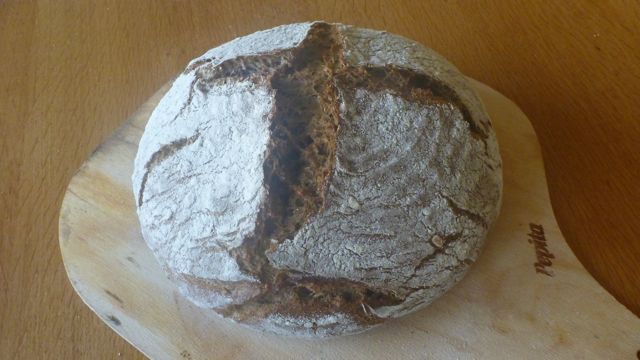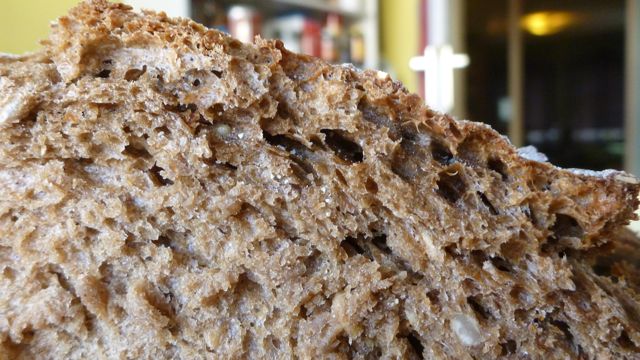I am currently in the process of putting together a multi grain unenriched loaf, relying on the tangzhong method to keep it nice and fluffy. Here is the latest result from its prettiest side:

But this is what I would like to talk about: on the dark side of the moon this is what is going on

The bread has ripped in quite some places in a way that I have never seen before. It makes it all look even more rustic, and that is fine, but I want to know the cause.
Here are some pieces of info that might help:
Multi grain, with manitoba, rye, oatmeal, barley, whole wheat and malt powder.
Made using a water roux; the famous Tangzhong method (that I love more and more every day!)
Baked on 220 C in a dutch oven. 20 minutes with lid, the rest of the bake without lid. Was it too hot in the first 20 minutes?
A friend of mine baked the same loaf not using a dutch oven, but a little tin foil tent and had the same cracks going in his dough.
The dough didn't spill out or anything. The cracks look more like "dry cracks", something hydration related.
The formula is on the dry side, about 54% AND there are quite some "heavy drinkers" in the mix, like oatmeal. Nevertheless the crumb is far from dry, and is actually remarkably fluffy (because of the tangzhong-method used)

Since the dough held quite some seeds, I added gluten powder, the formula called for 35 grams, which seems on the high side for a 1.1 kilo loaf. But I have never baked with it before, so I really don't know... Any idea?
Would love to hear back on this from you guys, thanks!
Freerk
I have used the water roux on many occasions and agree it is a great technique to use for a moist,lean whole grain bread. I just never knew the name. Thank you.
As for the cracks, could a simple explanation be that you have great oven spring,fairly dry crust on the dough and not enough scoring. Something has to give. I would try a more aggressive scoring on the next loaf and see what happens.
You mention it is a fairly low hydration bread.How did it fare after the first day? My instinct would be to increase the moisture, esp since itis a whole grain bread.
Looks delicious!
Hi Freerk,
I'll echo Chuck's point #3 in providing a more humid environment during final proof. You say the crumb is quite moist so hydration is not the issue, but with the various non glutinous grains you have in the mix you won't have the elasticity in the outer sheath of the dough that you would have in a higher percentage wheat dough. You might also try rounding/ shaping so that the loaf is a little slack, giving some room to move. Typically these types of dough are fairly low profile anyhow, but with some humidity correction in the final rise you should get the result you're after. I'd also recommend against using a dutch oven for this type of bread. Strong, initial bottom heat will set the crust sooner and help prevent the splitting if the final proof is adequate.
Keep us posted and good luck with the next bake,
Franko
Hey Franko!
I (tried) to make up for the non-gluten flours by (for the first time in my life!) adding gluten powder to the mix.
I guess in the end what happened is a combination of things (isn't it always when disaster strikes): I royally floured my banneton with rice flour, and that took more moisture away from the skin of the dough than I anticipated. I have noticed that most cracks appeared in the spots where the rice flour was "thickest". Also, being relatively inexperienced with manitoba, I feel I might have under proofed a little. This flour is really fast; last time I used it, I really had to step up my pace to keep up with it! I was using the oven for another bake, but it took only like 40 minutes for my first rise!
I have made pan breads similar to this one without any sign of cracking, so I learned that lesson; no more dutch oven for this one! And although I love my rice flour and its non stick capabilities, I'll have to cut back on the royal use of that too! And make 10 more loaves with manitoba to get a feeling for it. That last assignment won't be too hard with my ample supply!
Thanks for the feedback
Freerk
will work against you encouraging tear. If I was to tangzhong any of the flours, WW would be high on my list after a good soaking.
I would agree. Added yeast (faster rise) would also add to the cracking/expansion just like the dusting of the loaves with flour which subtracts moisture from the surface.
That's it!
I used a royal amount of rice flour whilst the dough was proofing in the banneton, and that is indeed a "heavy drinker"! It makes total sense now. Thanks Mini